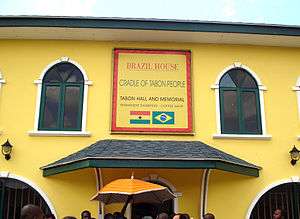Tabom people
The Tabom People or Agudas are the Afro-Brazilian community in South of Ghana who are mostly of Yoruba descent.[1] The Tabom People are an Afro-Brazilian community of former slaves returnees. When they arrived in South Ghana and Accra and they could speak only Portuguese, so they greeted each other with “Como está?” (How are you?) to which the reply was “Tá bom”,[2] so the Ewe people, Ga-Adangbe people and Akan people in of South Ghana and Accra started to call them the Tabom People.
Origins of Afro-Brazilian Community in Ghana
The Afro-Brazilian descendants and community in South Ghana dates back to one study from the 19th century that between an estimated 3,000 and 8,000 former slaves decided to return to Africa.[3]
Up to now it is not very clear, if the Tabom really bought their freedom and decided to immediately come back or if they were at that time free workers in Brazil, they came after the Malê Revolt of 1835 in Bahia. A lot of Afro-Brazilians when percecuted found their way back to Ghana, Togo, Bennin and Nigeria especially those who organised the Malê Revolt.[3] In Ghana it is common to find family names like de Souza, Silva, or Cardoso. Some of them have been very well known in Ghana.[3] The first Brazilian Ambassador to Ghana, Raymundo de Souza Dantas, arrived in 1961.[3]
Afro-Brazilians in Ghana

In Ghana, the representative group of people that decided to come back from Brazil is the Tabom People. They came back on a ship called SS Salisbury, offered by the British government. About seventy Afro-Brazilians of seven different families arrived in South Ghana and Accra, in the region of the old port in James Town in 1836.[3] The reception by the Mantse Nii Ankrah of the Otublohum area was so warm that they decided to settle down in Accra.[3] The leader of the Tabom group at the time of their arrival was a certain Nii Azumah Nelson.[3] The eldest son of Azumah Nelson, Nii Alasha, was his successor and a very close friend to the Ga King Nii Tackie Tawiah.[3] Together they helped in the development of the whole community in commerce.[3]
At the present moment the Tabom Mantse is Nii Azumah V, descendant of the Nelson’s. The Taboms are also known as the founders of the First Scissors House in 1854, the first tailoring shop in the country, which had amongst other activities, the task to provide the Ghanaian Army with uniforms.[3] Proof of these skills is without any doubt Dan Morton, another Tabom and one of the most famous tailors nowadays in Accra.[3]
In Ghana, the de Souza family can be found around Osu, Kokomele and other parts of the Greater Accra region and South Ghana. Sekondi-Takoradi and Cape Coast are also other bases.[3] Almost all of them remained along the costal regions of South Ghana.[3] However, it is very common to see a De Souza, a Wellington, a Benson, a Palmares, a Nelson, an Azumah, Amorin, Da Costa, Santos, De Medeiros, Olympio and other Afro-Brazilians in Ghana speaking perfect Ga-Adangbe language, Ewe language and Akan language. [3] This is because most of the Afro-Brazilian people got married to Ewe and Ga-Adangbes and Akans [3]
Because they were welcomed by the Ewe people, Ga-Adangbe people and Akan people and received by their kings as personal guests, the Taboms received lands in privileged locations, in places that are nowadays very well known estates, like Asylum Down, the area near to the central train station and around the Accra Brewery Company.[3] In those areas, the mango trees planted by them bear silent witnesses to their presence. In the estate of North Ridge there is a street called “Tabom Street”, which is a reminder of the huge plantations that they formerly had there.[3] Some of the Taboms live nowadays in James Town, where the first house built and used by them as they arrived in South Ghana is located.[3] It is called the "Brazil House" and can be found in a short street with the name “Brazil Lane”.[3] Because of their agricultural skills, they started plantations of mango, cassava, beans and other vegetables. They brought also skills such as irrigation techniques, architecture, carpentry, blacksmithing, gold smithing, tailoring, amongst others, which certainly improved the quality of life of the whole community.[3]
Nowadays the Taboms are completely integrated in the Ghanaian society and are a part of the Ga-Adangbe People, Ewe People and Akan People.[3]
See also
External links
- Short History of the Tabom People, Courtesy of the Brazilian Embassy in Accra, Ghana
- Book "Tabom. The Afro-Brazilian Community in Ghana"
References
- ↑ https://beegeagle.wordpress.com/2010/04/28/ghanathe-tabonyoruba-descendantsof-accra/
- ↑ "Tá bom? Tabom!". Folha de S. Paulo. Retrieved 8 December 2015.
- 1 2 3 4 5 6 7 8 9 10 11 12 13 14 15 16 17 18 19 20 21 Alcione Meira Amos e Ebenezer Ayesu "Sou Brasileiro: Historia dos Tabom, Afro-Brasileiros em Acra, Gana", Universidade Federal da Bahia, Brasil, 2005, Afro-Ásia, número 033